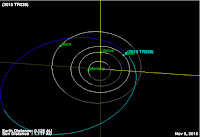Asteroid
2015 TD175 passed by the Earth at a distance of 4 054 000 km (10.6
times the average distance between the Earth and the Moon, or 2.71% of
the average distance between the Earth and the Sun), slightly after 6.00 pm on Wednesday 4 November 2015. There was no danger of the asteroid
hitting us, though had it done so it would have presented only a minor
threat. 2015 TD179 has an estimated equivalent diameter of 23-71 m (i.e.
it is estimated that a spherical object with the same volume would be 23-71 m in diameter), and an object of this size would be expected to
explode in an airburst (an explosion caused by superheating from
friction with the Earth's atmosphere, which is greater than that caused
by simply falling, due to the orbital momentum of the asteroid) in the
atmosphere between 20 and 3 km above the ground, with only fragmentary
material reaching the Earth's surface, though an object at the upper end of this range would explode with the equivalent energy to about 16 megatons of TNT (roughly 940 times the energy released by the Hiroshima bomb explosion), so being directly underneath it might be rather unpleasant.
The calculated orbit of 2015 TD179. JPL Small Body Database.
2015 TD179 was discovered on 13 October 2015 (22 days before its closest approach to the Earth) by the University of Hawaii's PANSTARRS telescope on Mount Haleakala on Maui. The designation 2015 TD179 implies that it was the 4479th asteroid (asteroid D179) discovered in the first half of October 2015 (period 2015 T).
2015
TD179 has a 1375 day orbital period and an eccentric orbit tilted at an
angle of 4.97° to the plane of the Solar System that takes it from 0.95
AU from the Sun (i.e. 95% of the average distance at which the Earth
orbits the Sun) to 3.89 AU from the Sun (i.e. 3.89% of the average
distance at which the Earth orbits the Sun, considerably more than twice the
distance at which Mars orbits the Sun). It is therefore classed as an
Apollo Group Asteroid (an asteroid that is on average further from the
Sun than the Earth, but which does get closer). This means that close
encounters between 2015 TD179 and the Earth are moderately common, with
the next predicted for October 2064. 2015 TD179 also has occasional close encounters with the planet Jupiter, with the next predicted in March 2078, though in this case a 'close encounter' implies a distance of about 1.7 AU, more than the distance at which the planet Mars orbits the Sun (about 1.5 AU), but close enough for the giant planet to excerpt a gravitational influence on the asteroid.
See also...
 Bright fireball over Saskatchewan and Manitoba. Many people have reported seeing a bright fireball over parts of
southern Saskatchewan and Manitoba at about 8.40 pm local tine on Sunday
8 November 2015. A fireball is defined as a meteor (shooting star)...
Bright fireball over Saskatchewan and Manitoba. Many people have reported seeing a bright fireball over parts of
southern Saskatchewan and Manitoba at about 8.40 pm local tine on Sunday
8 November 2015. A fireball is defined as a meteor (shooting star)... Asteroid 2015 TR238 passes the Earth. Asteroid
2015 TR238 passed by the Earth at a distance of 18 510 000 km (48.2
times the average distance between the Earth and the Moon, or 12.4% of
the average distance between the Earth and the Sun), slightly after 8.55
am on Friday 30 October 2015...
Asteroid 2015 TR238 passes the Earth. Asteroid
2015 TR238 passed by the Earth at a distance of 18 510 000 km (48.2
times the average distance between the Earth and the Moon, or 12.4% of
the average distance between the Earth and the Sun), slightly after 8.55
am on Friday 30 October 2015... Asteroid 2015 TF passes the Earth. Asteroid
2015 TF passed by the Earth at a distance of 11 550 000 km (30.0 times
the average distance between the Earth and the Moon, or 7.72% of the
average distance between the Earth and the Sun), slightly after 4.45 am
GMT on Tuesday 27...
Asteroid 2015 TF passes the Earth. Asteroid
2015 TF passed by the Earth at a distance of 11 550 000 km (30.0 times
the average distance between the Earth and the Moon, or 7.72% of the
average distance between the Earth and the Sun), slightly after 4.45 am
GMT on Tuesday 27...
Follow Sciency Thoughts on Facebook.

